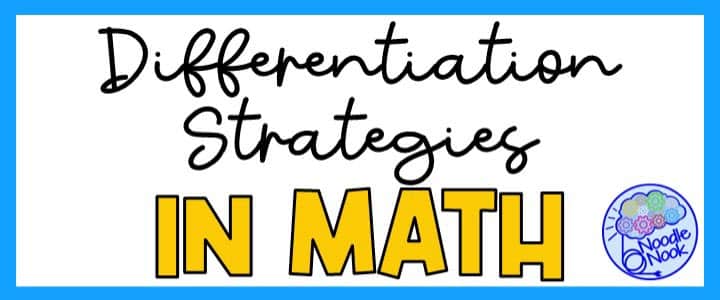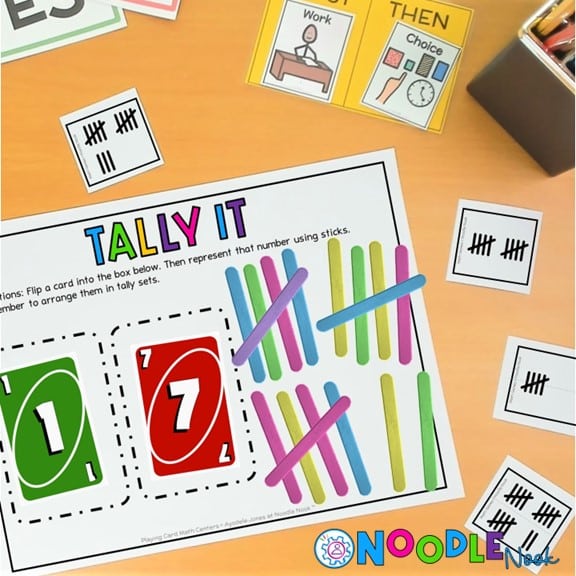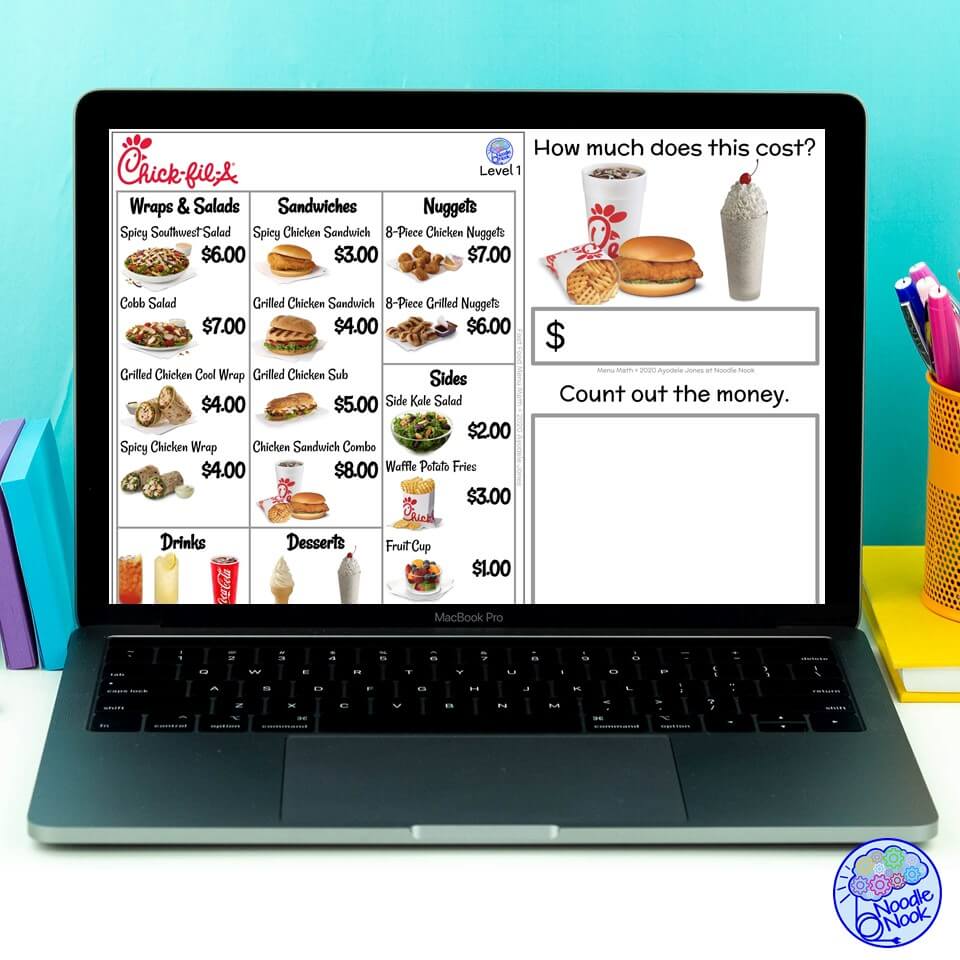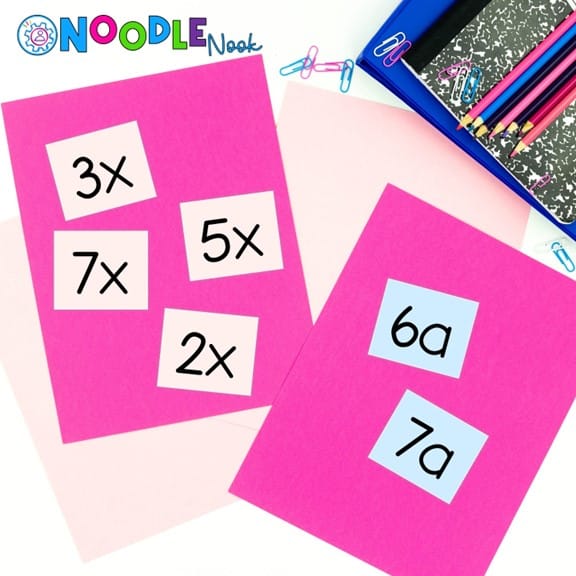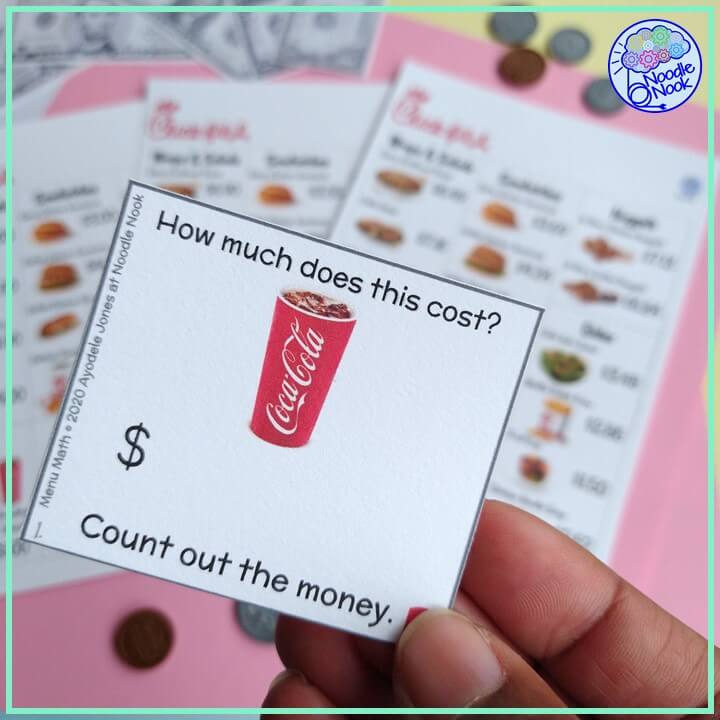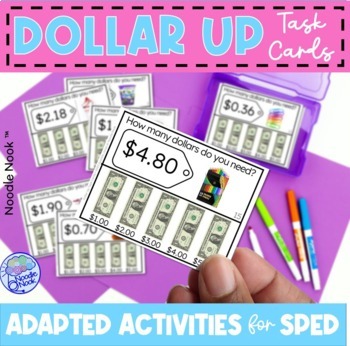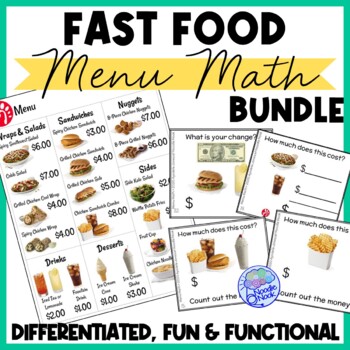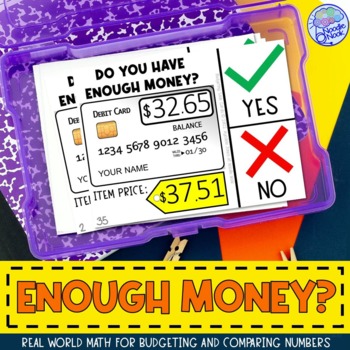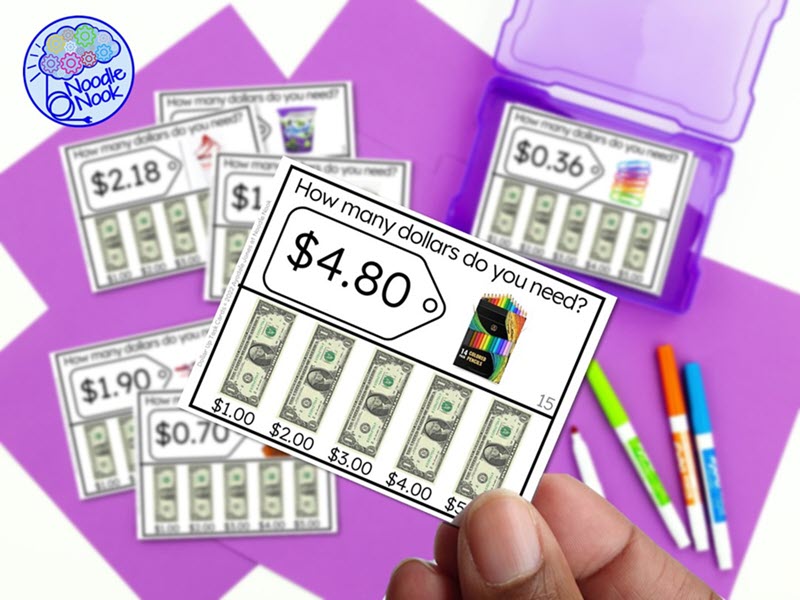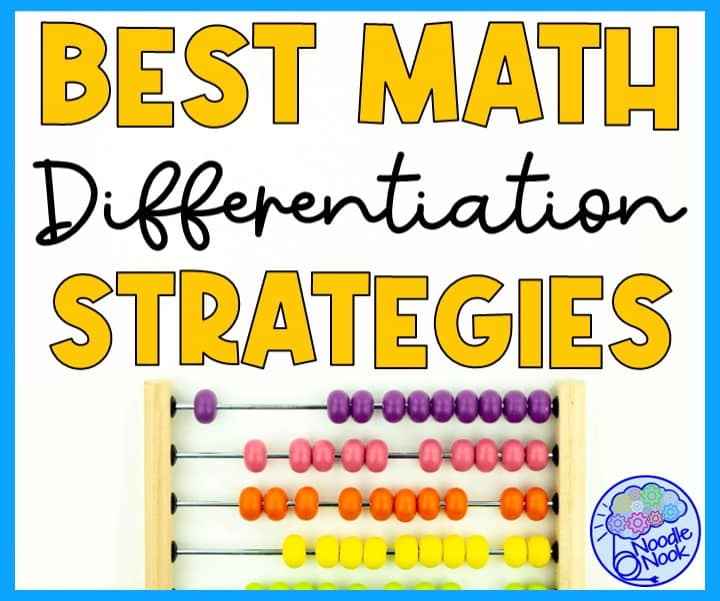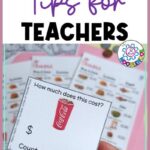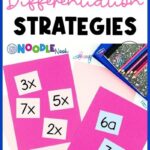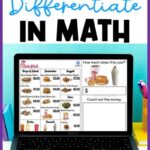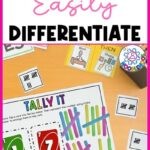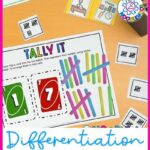Teaching math can feel like trying to solve a Rubik’s cube blindfolded and with one hand tied behind your back. But don’t worry, we’ve got you! In this post, we’re going to share some of the best math differentiation strategies that will have your special education students understanding math like a boss. So grab a cup of coffee (or wine, no judgment here) and get ready to take your special education instruction to the next level with these 5 best math differentiation strategies plus tons of bonus tips!
1. Use Manipulatives to Differentiate
When it comes to teaching math to students with severe and profound disabilities, using manipulatives or physical models is like a superhero’s secret weapon! These hands-on, concrete examples make abstract math concepts as clear as day, and help students to grasp them faster. What’s more, they support student learning at any grade level, no matter individual needs. So go ahead, bust out those blocks, counting bears and geoboards, and watch your students turn into math superheroes!
Beads and Bead Boards
A counting board with beads is a simple yet effective manipulative that can be used to help students with severe and profound disabilities learn basic counting and number recognition skills. Here are some steps a teacher can take to implement this strategy:
- Introduce the counting board and beads: Begin by showing the student the counting board and the beads. Explain that the beads can be used to represent numbers and that they will be using the beads and the counting board to practice counting and number recognition.
- Model counting with the beads: Start by placing a few beads on the counting board and count them out loud as you move them from one side of the board to the other. Repeat this a few times, emphasizing the number names as you count.
- Provide hands-on practice: Give the student some beads and have them place them on the counting board. As they do this, encourage them to count the beads out loud as they move them from one side of the board to the other. Provide verbal cues and prompts as needed to support the student’s counting.
- Gradually increase the number of beads: As the student becomes more comfortable with counting, gradually increase the number of beads they are working with. This will challenge them to continue to improve their counting and number recognition skills.
- Incorporate number recognition activities: As the student becomes more proficient with counting, incorporate number recognition activities. For example, you can show them a number card and ask them to find the corresponding number of beads on the counting board.
- Provide positive reinforcement: Provide positive reinforcement and verbal praise to the student when they successfully count and recognize numbers. This will help to build their confidence and motivation to continue practicing.
This hands-on approach is more meaningful and concrete. It’s a great way to easily differentiate PLUS it can also be written as a math IEP goal.
Number Lines
Number lines are another great manipulative and visual support to differentiate for students with disabilities. A number line with movable markers can be a useful tool for helping students with severe and profound disabilities practice addition and subtraction. Here are some steps a teacher can take to implement this strategy:
- Introduce the number line: Begin by showing the student the number line and the movable markers. Explain that the number line represents numbers and that the markers can be used to represent the numbers being added or subtracted.
- Model addition and subtraction: Start by placing markers on the number line to represent the numbers being added or subtracted. Model the addition or subtraction problem out loud and use the markers to demonstrate how the problem is solved.
- Provide hands-on practice: Give the student some markers and have them place them on the number line to represent the numbers in an addition or subtraction problem. Encourage them to count and solve the problem, providing verbal cues and prompts as needed.
- Gradually increase the difficulty: As the student becomes more comfortable with using the number line, gradually increase the difficulty of the problems. This can include using larger numbers, working with regrouping or borrowing, and solving more complex problems.
- Incorporate visual aids: To support students’ understanding you can use visual aids such as pictures, objects or real-life examples to represent the numbers in the problem.
- Provide positive reinforcement: Provide positive reinforcement and verbal praise to the student when they successfully solve an addition or subtraction problem. This will help to build their confidence and motivation to continue practicing.
Again, manipulatives can provide a tangible way for students to understand mathematical concepts and make connections to their everyday experiences. That makes them a great way to differentiate.
Manipulatives & the Twice Exceptional
Twice-exceptional students are students who are gifted and also qualify for special education services or a 504 plan. As a math teacher, the teaching-learning process may be different for these advanced learners who still have different ways of learning. Student differences mean we need to use targeted and effective strategies to meet the needs of individual students, including the twice exceptional.
For twice-exceptional students, it is important to differentiate the use of manipulatives or physical models to match their abilities and needs. For example, for a student who is gifted in math but struggles with visual-spatial concepts, using manipulatives that are multi-dimensional can help them to better understand geometric shapes and properties.
Additionally, providing opportunities for students to explore and experiment with manipulatives on their own or in small groups, can help to foster critical thinking and problem-solving skills which can be beneficial for twice-exceptional students.
2. Use Technology to Differentiate
Technology in the classroom has been prioritized over the last 20 years as we’ve all seen the rapid changes it can have on student access and understanding. Tech in the classroom is like a magic wand for differentiation! It allows us to meet our students where they are and help them understand concepts and demonstrate skills with ease.
Whether it’s using interactive math games, online tutorials, or speech output software, technology is the ultimate sidekick for special education teachers. It appeals to so many different learning styles! So go ahead, give it a wave, and watch your students’ understanding take off like a flying broomstick!
Calculators
Calculators hardly seem all that techie. In a world where we all carry one in our pockets all the time, however, it’s a tool students should know how to use. Using technology, such as a calculator or math software, can be an effective strategy for supporting students with severe and profound disabilities in math. These students may have difficulty with manual computation but can benefit from the support provided by technology.
Using a calculator with large buttons and high contrast display can be an effective strategy for differentiating instruction for a student with visual impairments. Here are some steps a teacher can take to implement this strategy:
- Assess the student’s needs: Before you start writing your lesson plans, begin by assessing the student’s specific needs. This will help determine the specific features of the calculator that will be most beneficial for the student.
- Provide the appropriate calculator: Provide the student with a calculator that has large buttons and high contrast display that will be easier for them to see and use. It’s important to check that the calculator has the necessary functions for the student’s level of math.
- Model using the calculator: Model using the calculator to solve mathematical problems. Show the student how to input numbers and use the calculator’s functions. This will help the student become familiar with the calculator and its features.
- Provide hands-on practice: Give the student some problems to solve using the calculator. Encourage them to use the calculator’s functions to perform calculations and check their work. Provide verbal cues and prompts as needed.
- Incorporate the calculator into instruction: Incorporate the calculator into the instruction, as appropriate. This can include using the calculator to solve problems, check work, and perform calculations.
- Monitor progress: Monitor the student’s progress, and provide feedback and support as needed. Adjust the instruction as necessary to ensure the student is making progress and is successful.
Math Software
Math apps and software are another way to differentiate your mathematics instruction. Software companies have plenty of options for personalized instruction and adaptive learning for students of all abilities. That may include interactive lessons, games, and assessments that can be tailored to meet the needs of individual learners. That takes a lot of the guesswork out of differentiation.
Accessing math software with speech output can assist a student with severe and profound disabilities to access the material and understand the instructions. That makes it an effective strategy for differentiating instruction. Here are some steps a teacher can take to implement this strategy:
- Assess the student’s needs: Begin by assessing the student’s specific needs related to their severe and profound disabilities. This will help determine the specific features of the math software that will be most beneficial for the student.
- Provide the appropriate software: Provide the student with math software that has speech output that will be easier for them to access the material and understand the instructions. It’s important to check that the software has the necessary functions for the student’s level of math.
- Model using the software: Model using the computer program or app to solve mathematical problems. Show the student how to navigate the software and use its functions. This will help the student become familiar with the software and its features.
- Provide hands-on practice: Give the student some problems to solve using the software. Encourage them to use the software’s functions and speech output to perform calculations and check their work. Provide verbal cues and prompts as needed.
- Incorporate the software into instruction: Incorporate the software into the instruction, as appropriate. This can include using the software to solve problems, check work, and perform calculations.
- Monitor progress: Monitor the student’s progress through observations and formative assessment. Then provide feedback and support as needed. Adjust the instruction as necessary to ensure the student is making progress and is successful.
These tools can provide students with an alternative way to engage with mathematical concepts and problem-solve.
Technology & the Twice-Exceptional
For twice-exceptional students, it is important to differentiate the use of technology by providing them with appropriate tools that match their abilities and needs. For example, for a student who is gifted in math but struggles with attention, using a calculator that has a built-in timer can help them to pace themselves and stay on task. Additionally, providing opportunities for students to use technology in a variety of ways such as research, communication, and problem-solving can help to foster creativity and critical thinking skills which are beneficial for twice-exceptional students in most math classrooms.
3. Flexible Grouping to Differentiate
Flexible grouping and small group instruction is like the secret sauce for success when it comes to differentiating instruction for students with significant disabilities. Flexible grouping allows us to mix and match students based on their abilities and needs. Meanwhile, small group instruction is like spice that takes it up a notch by providing helping us individualized attention and support. (Read more about stations and rotations here.)
Flexible Grouping Examples
As an example, a student with significant disabilities may struggle with basic math facts and concepts. A teacher can use flexible grouping to place this student in a small group with other students who are also struggling with math. The teacher can then provide targeted instruction and support, using manipulatives and visual aids to help the student understand concepts.
Another example, a student with significant disabilities may have difficulty with problem-solving. The teacher can use flexible grouping to place this student in a small group with other students who excel with problem-solving. By using peer modeling and peer interactions (like with cooperative learning), a student can benefit from learning in a peer group setting. Also, when a teacher spends time actively working with this group, they can focus more targeted interventions with the struggling student.
How to Implement Flexible Grouping
To implement flexible groupings in the classroom, start by assessing the student’s needs and abilities. Next, form small groups of students with similar needs. Then provide targeted instruction with lesson plans that use the differentiation strategies listed here. Be sure you’ve added in plenty of support using manipulatives, visual aids, or software.
Finally, the key to effective flexible groupings is to consistently monitor student progress. This allows you to easily and purposefully adjust the instruction or the groups based on student comprehension and mastery.
Ideas for Small Group
There is a time and place for using whole class instruction, maybe for introducing a concept or setting expectations for your learning environment. Otherwise, small groups, even for direct instruction, is just more effective. Your math lessons and overall classroom instruction will better meet student needs with smaller groups. It is one of the most effective ways math teachers can tailor their instructional strategies for students’ needs in a successful differentiated classroom.
There are many different types of activities that can be used in small groups for intervention and remediation. Some examples include:
- Skill-building activities: These activities are designed to target specific math skills, such as basic facts, computation, or problem-solving. Examples include flashcard drills, practice worksheets, and interactive games.
- Manipulative activities: Using manipulatives such as base ten blocks, pattern blocks, or geoboards can be a great way to help students visualize and understand mathematical concepts.
- Problem-solving activities: These activities are designed to help students develop critical thinking and problem-solving skills. Examples include word problems, logic puzzles, and real-world scenarios. Use practice problems that relate to high-interest ideas or an open-ended problem that helps students relate to a new skill.
- Games: Games can be a fun and engaging way to practice math skills. Examples include math bingo, math scavenger hunt, and math matching games.
- Interactive software: Interactive software can provide students with a variety of activities and exercises to practice math skills. Examples include math tutorials, interactive games, and online quizzes.
- Hands-on activities: Hands-on activities such as building with blocks, measuring, and graphing can help students to connect math concepts to real-world experiences.
The activities you choose will be more meaningful if they relate to a student’s real world. It also helps if they tap into student interests and preferences. #Engagement
4. Prior Knowledge to Differentiate
Differentiation using prior knowledge can be an effective strategy for students with significant disabilities. This approach involves assessing what a student already knows and building on that knowledge to introduce new concepts and skills.
For example, a student with significant disabilities may struggle with basic math facts and concepts. A teacher can assess this student’s prior knowledge by administering a pre-test to determine what facts the student already knows. Then, the teacher can provide targeted instruction and support, focusing on the facts the student is still struggling with, while also building on the facts they already know.
Pre-Teaching Matters
Another way of using prior knowledge in differentiation is through pre-teaching. A student with significant disabilities may have difficulty understanding new concepts because they lack the necessary background knowledge. In this case, pre-teaching can be used to build that background knowledge for different students before introducing the new concept.
Examples of Pre-Teaching
Consider a student with significant disabilities who struggles with understanding fractions. A teacher can use pre-teaching to build the student’s background knowledge by reviewing concepts such as counting, division, and basic fractions. The teacher can use visual aids, manipulatives, and interactive activities to help the student understand these concepts. Once the student has a solid foundation of background knowledge, the teacher can then introduce the new concept of fractions.
As another example, a student with significant disabilities may have difficulty understanding geometry concepts. A teacher can use pre-teaching to build the student’s background knowledge by reviewing concepts such as shapes, symmetry, and angles. The teacher can use visual aids, manipulatives, and interactive activities to help the student understand these concepts. Once the student has a solid foundation of background knowledge, the teacher can then introduce the new concept of geometry.
How to Implement Good Pre-Teaching
To implement good pre-teaching, start by identifying what background knowledge the students are lacking. Then, provide targeted instruction and support to build that background knowledge. This can be easily done by using video or pictures to quickly build context. You can also build prior knowledge by manufacturing a similar experience in the classroom. Like if a student has never seen snow and the lesson needs that for context and comprehension, you may use confetti in the classroom to mimic snow. Or, maybe use ice to understand how cold snow is.
Finally, monitor student progress and adjust the instruction as needed to ensure they understand the information and can connect with it.
2Es and Prior Knowledge
Using pre-teaching and prior knowledge with twice-exceptional students can be an effective strategy for differentiating instruction. Twice exceptional students, often referred to as 2e, possess both high abilities and significant disabilities, which can present unique challenges in the classroom.
For twice-exceptional students, pre-teaching can be used to build background knowledge, but it is important to differentiate the instruction to match their abilities and needs. For example, a twice-exceptional student who is gifted in math but has a learning disability may benefit from more in-depth and complex pre-teaching activities that challenge them while still building the necessary background knowledge.
Prior knowledge assessment also can be different for twice exceptional students. For example, a twice-exceptional student who is gifted in math but has a learning disability may already have a deep understanding of certain math concepts, but they may struggle with other concepts. The teacher should use prior knowledge assessment to identify the student’s strengths and areas of need and then provide instruction that matches their abilities and needs.
5. Choice Boards to Differentiate
Differentiation using choice boards can be an effective strategy for students with significant disabilities. A choice board is a tool that allows students to select from a variety of activities or tasks that align with a specific learning objective. This approach allows students to work at their own pace and level of understanding. This may be something you do with specific students for specific skills, or your entire class. Either way, it’s a way to help students, both on-pace and struggling students, access different activities and use different approaches to learn better. Plus, choice boards make it easy to use student interest in creative ways to keep them engaged.
Examples of Using Choice Boards
Take, for example, a student with significant disabilities may struggle with basic math facts and concepts. A teacher can create a choice board with a variety of activities that focus on basic math facts such as flashcard drills, practice worksheets, and interactive games. The student can then select the activities that best align with their learning needs and work on them at their own pace.
For a student with significant disabilities who has difficulty with problem-solving, choice boards work. The teacher can create a choice board with a variety of activities that focus on problem-solving such as word problems, logic puzzles, and real-world scenarios. The student can then work through the activities at their own pace at an independent center or workstation. This type of structured work system can really support students who are more rigid in their learning style.
Choice Board Ideas
There are many different ideas that can be included on a choice board for early elementary students. Some examples include:
- Picture matching: This activity can be used to help students learn basic concepts such as shapes, colors, and numbers. It can involve matching pictures to words or matching pictures to other pictures.
- Counting practice: This activity can involve counting objects, such as counting bears or counting blocks.
- Sort and classify: This activity can involve sorting objects by different attributes, such as size, shape, or color.
- Patterning: This activity can involve creating patterns using different materials, such as blocks, beads, or manipulatives.
- Math games: This activity can include interactive math games that help students practice basic math concepts such as addition, subtraction, and counting.
- Story problems: This activity can include word problems that help students practice problem-solving skills.
- Hands-on Activities: This activity can include building with blocks, measuring, and graphing can help students to connect math concepts to real-world experiences.
- Interactive software: Interactive software can provide students with a variety of activities and exercises to practice math skills.
These are just examples. You’ll want to adjust the choice board to the student’s abilities and needs. Also, it is important to keep things age appropriate. If you’re working with students in middle school, do not bust out counting bears. Age-appropriate materials should always be used, no matter the developmental age or academic level. Elementary teachers, use all the bears you like!
Choice Boards for Older Students
Choice boards for math at the secondary level, think middle school and high school aged students, can be a great way to differentiate instruction. The activities on the choice board should be age-appropriate but still tailored to the student’s abilities and needs. Here are some examples of activities that can be included on a choice board for middle school students who are several years behind:
- Practice worksheets: These worksheets can focus on specific math concepts such as fractions, decimals, or geometry, and provide different levels of difficulty.
- Interactive math software: This can include online tutorials, games, and quizzes that provide interactive practice with math concepts.
- Word problems: These problems can be used to help students practice problem-solving skills and apply math concepts to real-world scenarios.
- Real-world applications: These activities can involve using math concepts to solve real-world problems, such as budgeting, measurement, or data analysis.
- Manipulative activities: These activities can involve using manipulatives such as base ten blocks, pattern blocks, or geoboards to help students visualize and understand mathematical concepts.
- Games: Games can be a fun and engaging way to practice math skills. Examples include math bingo, math scavenger hunt, math matching games.
- Videos and tutorials: These can be used to provide students with an alternative way to learn math concepts, for example, visual learners may benefit from videos that explain math concepts and procedures.
- Collaborative activities: These activities can involve working with a partner or in a small group to solve problems or complete a project related to math concepts.
These examples should help you to make differentiation easy.
RECAP: Best Math Differentiation Strategies
We covered five effective math differentiation strategies for special education students. These instruction strategies include using manipulatives or physical models, technology, flexible grouping, prior knowledge, and choice boards. Each strategy offers unique benefits and can be tailored to meet the specific needs of your students.
One of the most important things to remember when it comes to teaching math to students with disabilities is the maintain high standards. They should not be doing completely different things because they have an IEP. Instead, special ed students should be included in grade-level lessons and exposed to challenging concepts. If you’d like more targeted professional development on addressing common issues for mathematics teachers in special ed, check out the sessions through Noodle Nook.
These are some of the best math differentiation strategies because they are easy to use and highly customizable. With the right support and guidance, these strategies can empower special education students to unlock their full potential and achieve success in math.
Article Citation: [cite]
